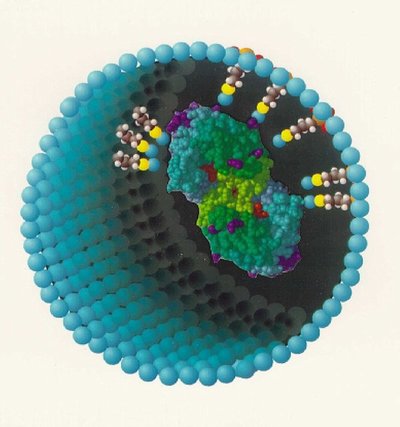April 17, 2001
UW and Pacific Northwest National Laboratory think big, aim small with creation of new joint nanotechnology institute
The science of the very small is about to get bigger in the Pacific Northwest.
The University of Washington and the Department of Energy’s Pacific Northwest National Laboratory have formed the Joint Institute for Nanoscience and Nanotechnology to study an area of science that holds the promise to dramatically change the way we live in the new century.
The new institute, created under an agreement signed today, will push area scientists further onto the cutting edge of nanoscience by bringing together two already formidable players in the field.
“Together, we can leverage our research capabilities to assemble a stronger scientific team than either of us would have individually,– said Bill Rogers, associate laboratory director of PNNL’s Fundamental Science Division and director of its Nanoscience and Nanotechnology Initiative. “Nanoscience is an area that requires teams of scientists from various disciplines to work together to solve problems. PNNL excels at multidisciplinary research, and we’re taking that teaming approach one step further by signing this agreement.–
Alvin Kwiram, vice provost for research at the UW, said officials have been looking for ways to increase collaborations between the university and the laboratory for several years. The joint institute will foster a more focused relationship and set the stage for initiatives in other areas, he said.
“Although nanotechnology will be the first theme to benefit from the joint institute concept, other themes are under discussion as well,– Kwiram said. “The resources of the two institutions are very complementary, and this sort of collaboration is a powerful tool in meeting the broad challenges of our time that are important to the nation and to society.–
The agreement calls for each partner to provide $500,000 a year for administering and supporting the joint institute.
Nanoscience and nanotechnology deal with the building of new materials and extremely small machines by manipulating individual atoms or molecules. Such devices are measured in the billionths of a meter — the width of about four atoms or 1,000 times smaller than the thickness of a human hair. The field holds the promise of a world of vastly improved technologies: computer chips that could store trillions of bits of information in an area the size of a pin’s head, biologically compatible devices that could attack disease at the sub-cellular level, or materials designed at the atomic level that could revolutionize consumer goods.
“Nanotechnology will not only be to the 21st century what microelectronics was to the past century, but it will impact all aspects of our lives, from materials to health to communication,– said Viola Vogel, director of the UW’s Center for Nanotechnology. “Everything we now know of will be lighter, faster and work with less power.–
To explore the rapidly developing field, PNNL brings to the newly formed institute the resources of a national laboratory, including an established multidisciplinary team of scientists. The laboratory features a unique collection of instrumentation in the nanomaterials and technology facility located at the William R. Wiley Environmental Molecular Sciences Laboratory, a DOE user lab on PNNL’s Richland campus. In this nanoscience facility, PNNL scientists are designing, manipulating and characterizing materials on the nanoscale, such as quantum dots, nanotubes and nanoporous films. Through EMSL, post-graduate students and professors at the UW will have access to instrumentation and experts that complement and expand university capabilities in nanoscience. PNNL expects to have the world’s most powerful nuclear magnetic resonance microscope later this year when it receives a 900-megahertz system from Oxford Instruments of England.
The UW has established a strong presence in nanotechnology and last summer became the first university in the nation to launch a doctoral degree program in the field. About 30 professors teach courses through the Center for Nanotechnology, which pulls together resources from among nine departments. PNNL scientists will have an opportunity to teach and do research at the university under the affiliation agreement.
Progress in nanoscience will depend on the combination of a variety of approaches, and this institute will integrate expertise in nanobiology, material synthesis, characterization and theory modeling. PNNL and UW are already collaborating on some nanoscience projects. For example, scientists from both institutions are investigating the proteins that impact mineral levels found in bones, teeth and kidney stones. The PNNL scientist involved with this research, Dr. Allison A. Campbell, has been named an affiliate associate professor at the university, which allows her to conduct joint research and mentor students.
Dr. Lura Powell, director of PNNL, made the joint institute one of her highest priorities upon assuming the reins of the laboratory last summer. UW President Richard McCormick and Provost Lee Huntsman endorsed the concept early on in discussions with laboratory leaders and encouraged further development of a closer working relationship. Regent Dan Evans, who served on the laboratory advisory committee, also supported strong collaboration between the organizations.
The institute partners represent two of the largest research organizations in the Northwest. PNNL conducts more than $500 million a year in research for the Department of Energy and Department of Defense, as well as other federal agencies and private companies. The UW is the state’s largest public university and garnered $650 million in public and private research money last year.
###
More information can be found on the Web at http://www.nano.washington.edu and http://www.pnl.gov. Vogel can be contacted at (206) 543-1776 or vvogel@u.washington.edu, and Kwiram is at (206) 543-6616 or kwiram@u.washington.edu. To interview Rogers, call Staci Maloof at (509) 372-6313.
High-resolution color images are available on the Web. An image showing machinery used at PNNL to investigate how nanostructures can be used to control and enhance chemical reactivity is at http://www.washington.edu/newsroom/news/images/react.jpg. Photo credit should go to Pacific Northwest National Laboratory.



